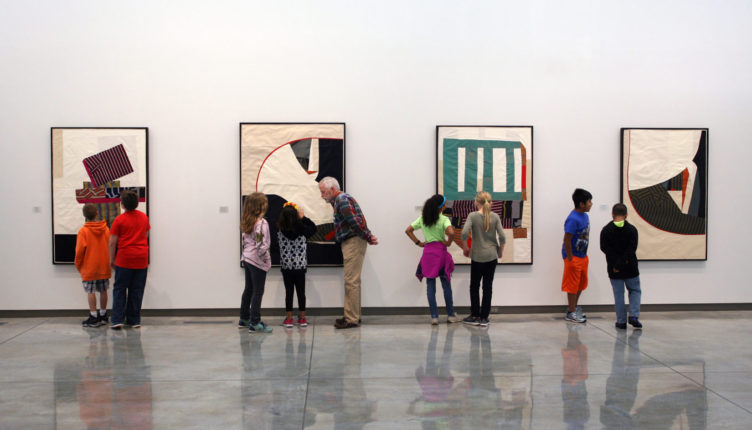Whether you are looking for diversion on a rainy afternoon or a deeper appreciation of local culture and history, you won’t need to hop on a plane to Chicago or New York for a first-rate museum experience.
The best thing about mid-Missouri’s many museums isn’t that it takes only a quick drive to find one. You can leave the everyday world of the mundane behind and slip away into the past or immerse yourself in the most recent work of artists — some who may be accomplished neighbors; others who have already achieved national and international fame. Great works of art and artifacts from the distant past are only a few miles from where you live.
Boonville Visitors Center and River, Rails & Trails Museum
100 E. Spring Street, Monday – Fridays 8:30 a.m. to 4 p.m. year-round, and 10 a.m. to 2 p.m. Saturday and Sundays, April through October. No charge.
Before travelers could cruise Highway 70 to Boonville, the only way to get to this river city was by boat, train or a horse-pulled buggy over rutted trails. Although those days are over, they are brought back to life at Boonville’s new museum. The city’s Visitors Center and the River, Rails & Trails Museum is the starting place for exploring Boonville and its past. Located just across from the Isle of Capri Casino Hotel in the historic depot district, the center and museum are housed in a restored building that was home to the Hirsch Wholesale Grocer Co. in 1902. Look for the wholesale grocer’s painted black and white sign on the building, next to the old-fashioned advertisement for Newton’s Fidelity Flour, a popular flour in the early 1900s.
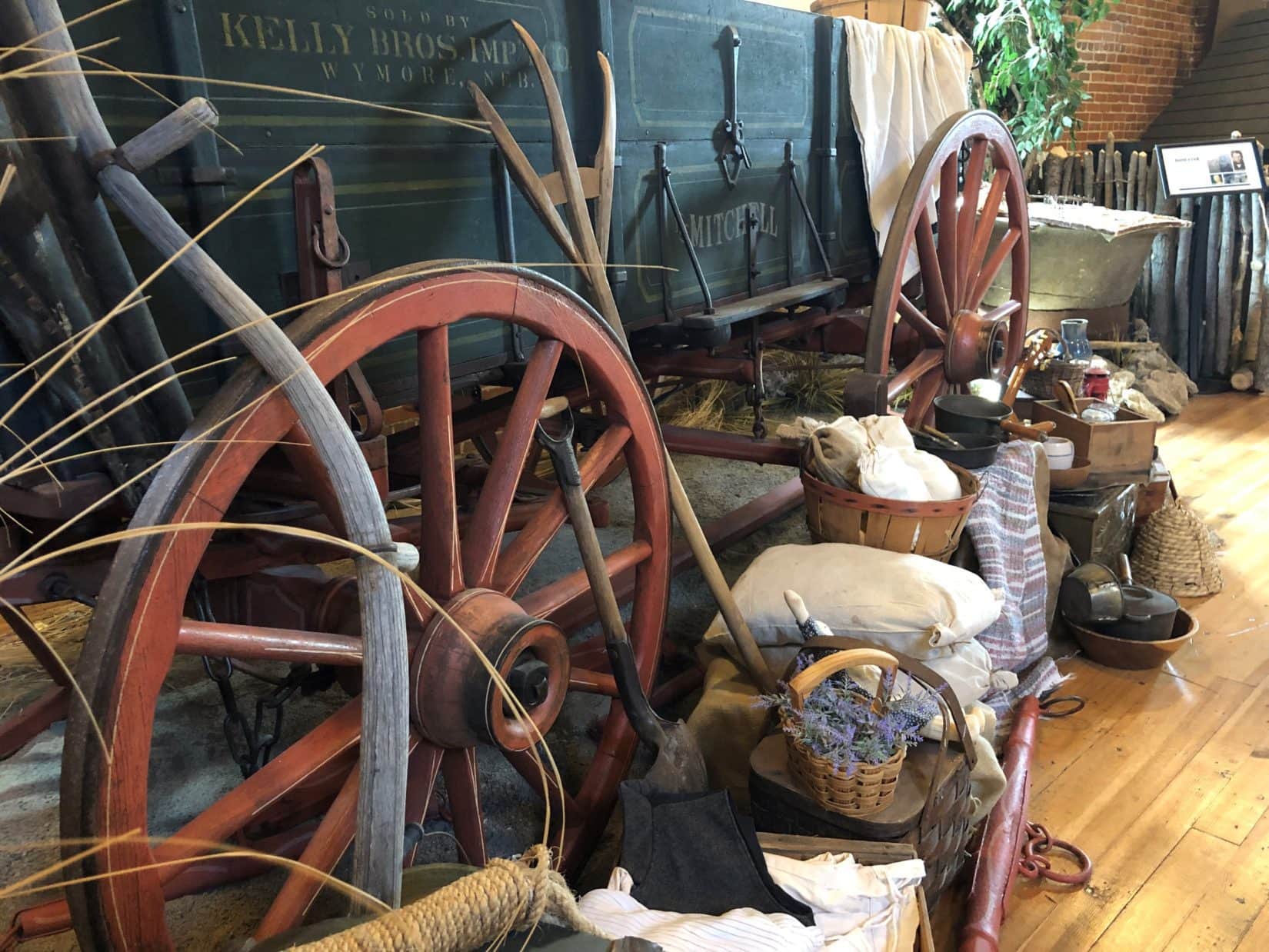
In addition to brochures, maps of the area and snack foods, the Visitors Center is the only place tourists can arrange tours of the Mitchell Antique Motorcar Museum. It’s also a convenient resting spot for bicyclists needing a break from their trek along the Katy Trail.
The museum displays models, photographs and artifacts that bring an entertaining focus to Boonville’s past. It’s a kid-friendly place, where children can press buttons that turn a model steamboat’s paddlewheel. Children can also try on pioneer clothing and play in a small stockade. For 25 cents, children (and adults) can start a model train on its five-minute journey through its tabletop setting, a model of Boonville in the 1950s.
Parts of The Missouri Packet, a steamship that sank in 1820 not far from Boonville, are displayed along with newspaper accounts of its sinking. According to rumor, the 60-ton steamboat carried $250,000 worth of cargo at the time it went under.
Before the age of the steamboat, travelers explored the territory in keelboats. One of the museum’s main features is a half-scale wooden replica of the keelboat that carried Lewis and Clark on their 1804 journey along the Missouri River. Other artifacts include a Mitchell farm wagon, which was in wide use before cars and trucks drove horse-pulled wagons off the road and into museums.
The museum also displays the history of the Kemper Military Academy, founded in 1844. Among its famous graduates are American humorist Will Rogers and George Linsey, who played the role of Gomer Pyle on the “Andy Griffith Show.”
Mitchell Antique Motorcar Museum
210 E. Spring St. Boonville, 8:30 a.m. to 4 p.m. Monday through Fridays. 10 a.m. to 2 p.m. weekends. $5 ticket for a tour or $10 to tour with the owner of the collection up to three hours. Purchase tickets at the Boonville Visitor’s Center, a half-block away.
Who ever heard of a Mitchell Motorcar? And why is there a museum dedicated to the cars in Boonville? Spend an hour or so at this museum and you’ll leave with an appreciation of the car and the efforts of the company’s great-great grandson to preserve a major piece of American automotive history.
As the tour guide explains, the Mitchell company started out as a wagon manufacturer in 1834 in Fort Dearborn, an outpost that would eventually become Chicago, Illinois. From wagons, the company expanded into bicycles before introducing its first single-cylinder car in 1903. After moving to Racine, Wisconsin, the company kept expanding production, building more sophisticated cars, and a variety of models. At its peak in 1915, Mitchell Motorcars was a colossal in the car industry, employing 10,000 workers at its 75-acre plant.
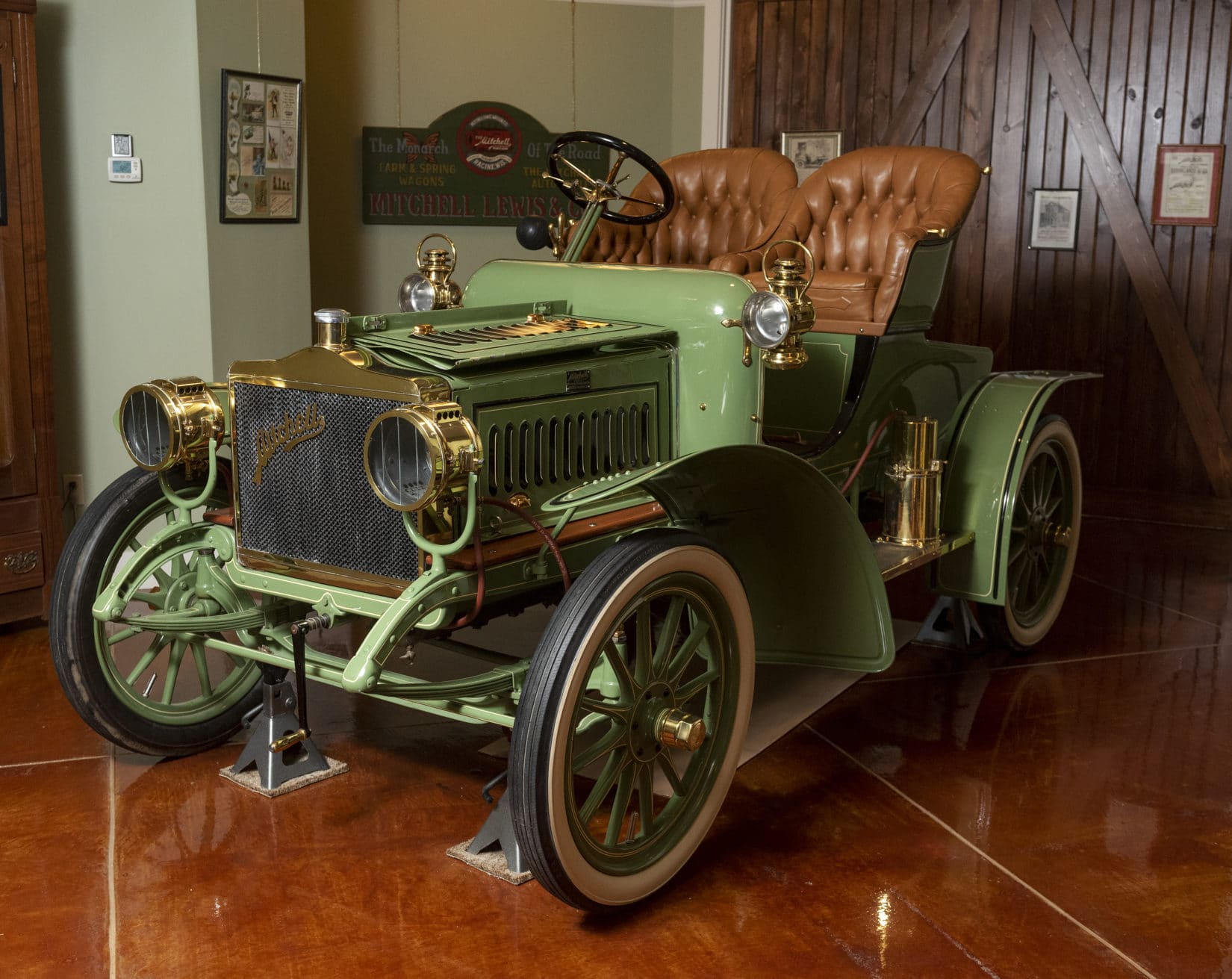
Unlike the lower-priced Ford Model A, Mitchells were more of a luxury car and came in a variety of colors and styles. Its 1904 Roundabout model featured kerosene headlamps that had to be hand lit. As technology progressed, the kerosene was replaced by carbide gas, and eventually by bulbs. Several of the cars bear a strong resemblance to the Ford that was featured in “Chitty Chitty Bang Bang” — minus the wings.
The 1910 limousine-style model on display has a glass divider between the driver and the passenger coach. If passengers wanted to address the driver, they used a brass speaking tube embedded in the divider.
In addition to the cars, Lewis displays one of Mitchell’s motorbikes and the only known Mitchell bicycle. There may be more bicycles out there in trash piles or bargain barns, says tour guide Cheryl Gates. “Mike and Frank from ‘American Pickers’ are looking for any others,” she says.
Before leaving the museum, it’s worth asking your guide to play the tape of a song that was popular early in the 1900s. The sheet music is just above the museum’s tape player, and you can follow along as the tinny voice sings, “Give Me a Spin in Your Mitchell, Bill.”
The Missouri State Museum
Missouri State Capitol, Jefferson City, open to the public from 8 a.m. to 5 p.m. every day of the year except holidays. No charge.
The building itself is enough reason to stop at the state Capitol. Built more than 100 years ago, its dome towers 262 feet above ground level. Columns, statues, neatly manicured landscaping —this massive limestone structure is symbolic of the power of state government. Once inside, follow the marble hallways to find your way to the museum on the first floor, in the center of the building.
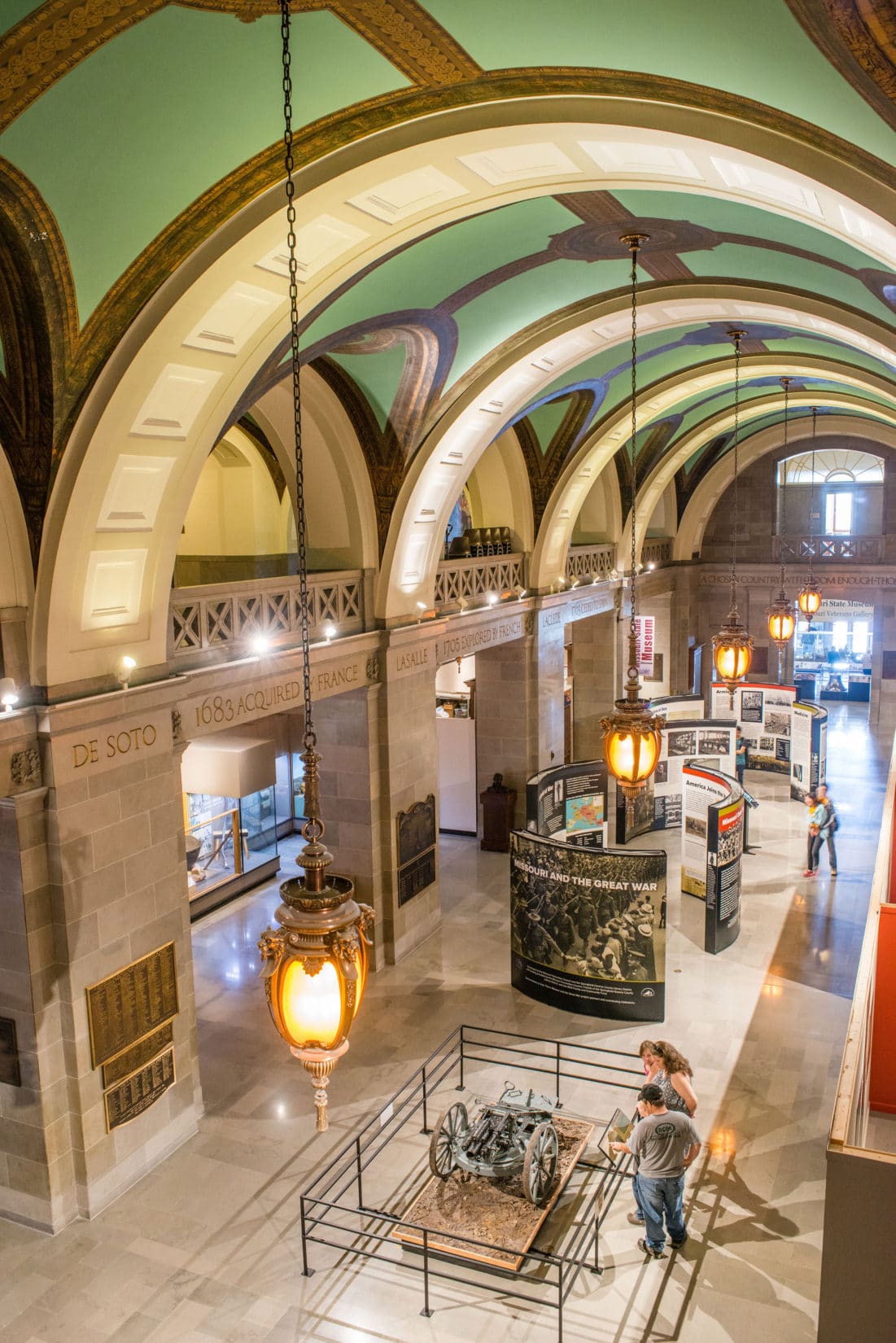
The Missouri State Museum extends along the halls radiating from the rotunda. Anyone interested in just about any aspect of Missouri’s history will find something to appreciate in this museum. Covering culture, as well as natural resources and industry, it’s a fun way to introduce children to the state’s history.
One of the wings is devoted to a display on World War I, with special emphasis on Missouri’s role supporting the war effort with recruits, both human and equine. A poster explains that 156,000 Missourians served in the military during the war, resulting in 11,000 Missouri casualties. But who knew that Missouri mules were an important part of the war effort? About 130,000 mules were shipped overseas from Missouri to pull loads for U.S. and allied forces. And it was a Missourian, General John J. Pershing, who commanded the American Expeditionary Forces on the Western Front. Plenty of posters from the war years and captured German military artifacts help make the war into more than just a dry history lesson.
Sections of the museum focus on pre-settlement years, frontier years and the expansion of settlement and the development of industry in the state. One section looks at slavery and the contribution of African Americans to the arts and commerce of Missouri. The time span covered by the various displays extends from 10,000 BC, when the first hunter-gatherers found their way into the area, up to the present.
Children, who may have little interest in the explanations posted by exhibits, will enjoy the many displays that contain artifacts, such as pioneer rifles, fossils, military uniforms from the past, arrowheads and even a stage coach that used to carry mail and passengers from Palmyra to Iowa.
Among the famous Missourians highlighted are Carry Nation, Dred Scott and Josephine Baker. A mural illustrating some of the paintings of Thomas Hart Benton is displayed in the center of the museum, and paintings of governors are along the walls.
The portion of the museum about Missouri’s industries features a large model of a lead mining operation that fascinates adults as well as children. Other parts of the state Capitol building are museum-like though not officially part of the museum. Historic paintings can be found on every floor of the Capitol. The third-floor rotunda features the hall of famous Missourians and the work of Thomas Hart Benton and other Missouri artists. Plan on spending a few hours exploring the museum, the building and the grounds. You’ll go away with a greater appreciation of Missouri’s resources and its people.
Missouri State Penitentiary Museum
700 E. Capitol Ave., Jefferson City, Monday – Fridays, 8 a.m. to 4 p.m., $2.
This museum is for people who have a taste for the sensational with a dash of the macabre. Anyone who watches “Orange is the New Black” might enjoy spending 30 to 45 minutes in the dank, narrow passageways of the Missouri State Penitentiary Museum. It’s an alternative to a walk-thru tour of the Missouri State Penitentiary.
The museum is located in the basement of the Col. Darwin W. Marmaduke House, just across from the penitentiary’s foreboding guard tower that sits atop limestone walls. Although the penitentiary started housing prisoners in 1836, the colonel was the first warden to live in the building, moving in with his family in 1888. It wasn’t until 2004 that the prison closed down and prisoners were relocated to more modern facilities.
Visitors entering the basement doors on the building’s west side find themselves directly across from the steel bars of a reconstructed prison cell. A mannequin, wearing a black and white striped prison uniform, stands next to a bed. The only other furniture in the cramped cell is a primitive toilet and a couple tables, one with a checkboard on it, the other supporting an ancient TV.
The mannequin has a bleak look to him, matching the sadness of his environment. A poster on the cell explains some prison jargon, while another one explains that in 1841, three men typically shared a 12-foot by 8-foot cell. They don’t sugarcoat the prison experience in this museum.
Old photos illustrate the hardship of prison life during the century and a half that the prison housed men and women who had been convicted of serious crimes. Throughout the museum, examples of prisoners’ arts and craftwork are displayed. These works include leather wallets, purses, carved leather scenes, the occasional painting and even a house built of popsicle sticks.
One room is dedicated to high-profile prisoners who had served their time in the penitentiary. Among these infamous and sometimes famous convicts were Pretty Boy Floyd, famed boxer Sonny Liston and Lee Shelton, a pimp and thief who gained fame in the song that recalled his crime of stabbing Billy Lyon. That song, “Stagger Lee,” still gets airtime on oldies radio stations.
Contraband knives, axes and other homemade shivs are also displayed, as are billy clubs and menacing looking leather-covered line sticks, used — as the name implies — to keep prisoners in line.
For those who are curious about how death sentences were carried out, the museum displays a gray metallic box with several switches and lights imbedded in its top. The box looks harmless but was used to administer lethal injections. This museum is definitely not for the squeamish or young children, but it is for those who want an honest, hard look at what prison life was like for those unfortunate enough to serve time in the penitentiary.
Boone County History and Culture Center
3801 Ponderosa St., Columbia, Wednesday – Saturdays, 10 a.m. to 5 p.m., Sunday 12 p.m. to 5 p.m. No charge.
There’s a lot to see and a lot going on at the Boone County History and Culture Center. And it’s in the lot that the displays begin. Visitors entering the parking lot that faces Highway 63 have to drive by the wooden and glass pavilion that serves as the final resting place of the River Horse. This is the 18-foot dory that carried Boone County author William Least Heat-Moon, along a 5,000-mile journey he documents in his book named after the boat.
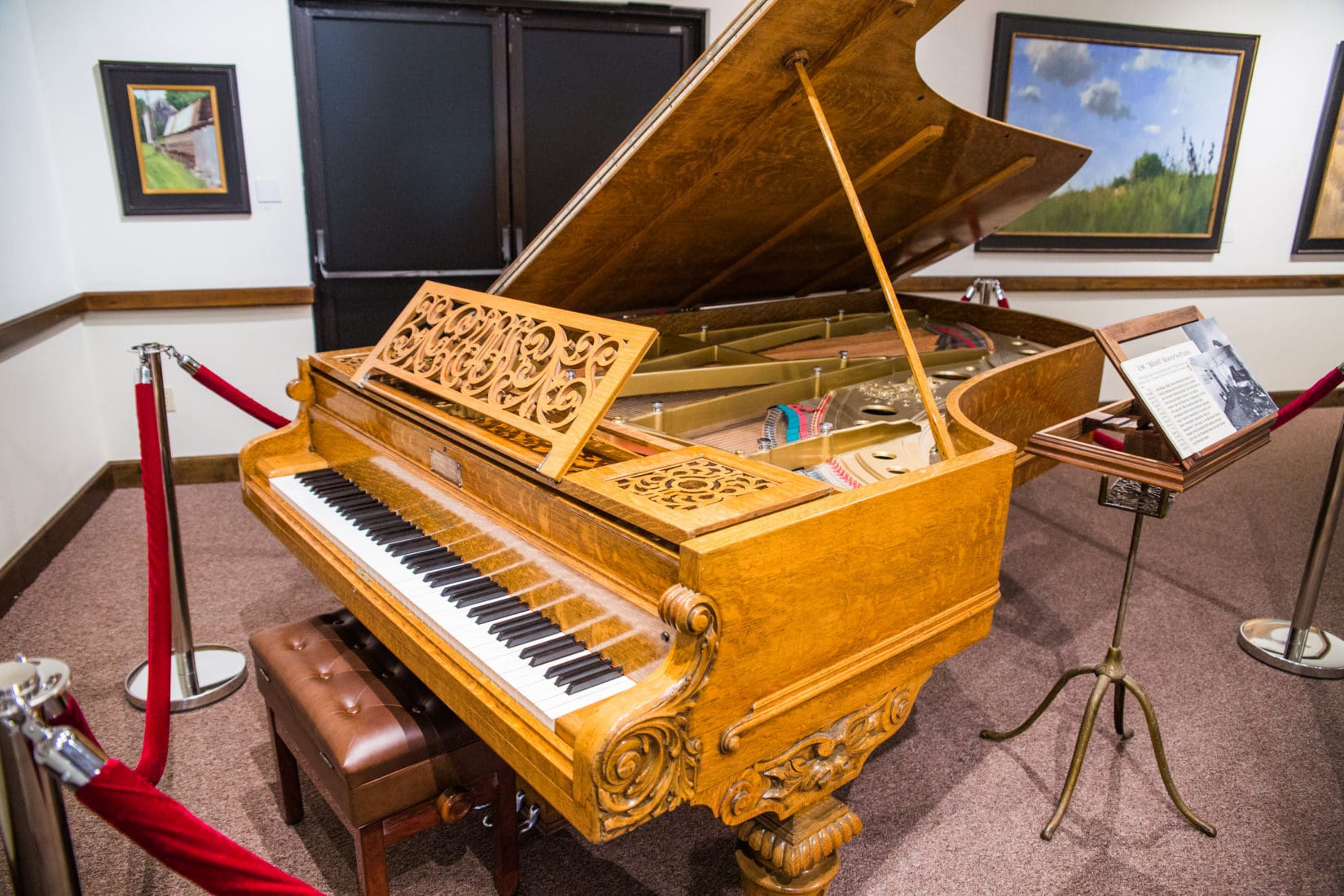
Unlike some museums that restrict their displays only to their prominent citizens, the Boone County History and Culture Center also reflects the images of ordinary citizens who have lived in the area. Its “The Faces Found: Boone County Portraits 1886-1940” exhibit, which recently closed, was a moving tribute to everyday Columbians. The display told the story of how several stashes of glass photographic plates were discovered, then developed and digitized. Against all odds, the plates yielded clear images from the files of professional photographers. That display is being replaced by the “Boone County Bicentennial Exhibit – 1820-2020,” which opens on Feb. 19.
In one of the other galleries, the Center and the League of Women Voters have created “She Got the Vote,” a display about the suffrage movement in Boone County and Missouri. Visitors can view photos and bios of Boone County suffragettes Jane Addams, Rosa Russell Ingles and Helen Guthrie Miller. Included in the display are minutes from a local meeting of the Columbia Equal Suffrage League, clothing from the era and the pen used by Missouri Gov. Frederick D. Gardner to sign the Presidential Suffrage bill in 1919.
Moving from the past to the present, the center features the work of local artists in the Montminy Art Gallery. Not only can outstanding works be viewed, but they can be purchased. The gallery is also the home of John William (Blind) Boone’s restored piano. Blind Boone was a musical genius who created a distinct version of Ragtime. Although he and his wife lived in Columbia, he toured North America, playing Ragtime and classical piano masterpieces.
Outside the Boone County History and Culture Center, there’s a collection of buildings that look like a small village, and they are. From April 1 through Oct. 31, the Village at Boone Junction can be toured for $5 per adult and $3 per child ages 5-14. Each of the buildings in the village represents an architectural style from the area’s past. The oldest is the Gordon-Collins log cabin, which was built in 1818. A replica of the Easley Country Store stands across from it. And nearby is the McQuitty House, built in 1910 by Luther McQuitty, an African-American contractor and realtor. Adjacent to that is the Ryland Farm House, a late-Victorian-era home that is an example of a style popular in the late 1800s.
Throughout the year, the center hosts musical concerts and a popular Meet the Author Series. As a vital part of the area’s heritage and culture, the center brings the past into the present in an entertaining and educational manner.
The State Historical Society of Missouri
Center for Missouri Studies, 605 Elm St. Columbia. Tuesday through Friday, 8:30 a.m. to 4:30 p.m., Saturday 8:30 a.m. to 3 p.m., closed Sunday and Monday. No charge.
Open since August, the Center for Missouri Studies is an architectural masterpiece. Its design is an interpretation of Missouri’s landscape, featuring curved limestone walls, suggestive of cliffs above our state’s streams and rivers. Its gray floors resemble creek beds, and its swooping wooden stairwell shares the curves of a meandering Missouri river. Even its windows are designed to be constantly changing, reflecting the surrounding area like water.
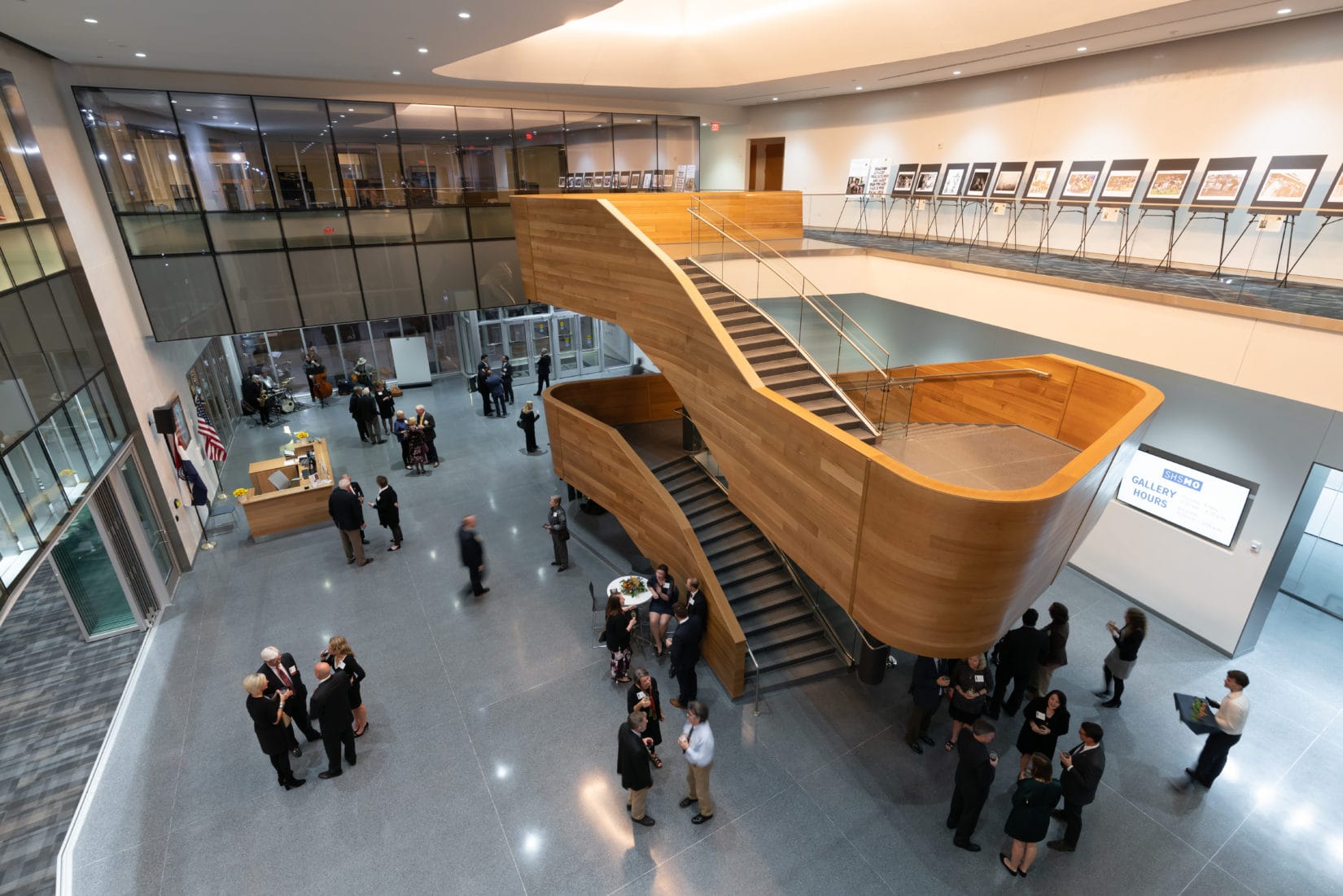
But this impressive building is more than a collection of features. It is a public space, a place of calm white light and cathedral-high ceilings — a setting for contemplating art and studying archival texts available for the public. As practical as it is appealing, it includes a parking lot on its north side. Stopping by for a visit is easy, relaxed and meter-free.
The center functions as a library and a museum. For patrons interested in learning about various aspects of Missouri’s past, professional staff help find the documents they need in the center’s immense collection of historic documents. Its archives include more than 8,000 maps, almost 5,000 oral history interviews, 100,000 photographs and 9,000 manuscript collections. Much of this can be accessed on the web.
But the best reason to plan a visit to the center is to wander into its first-floor art gallery. Like any other first-rate art museum, it provides an inspiring space to appreciate the work of great artists. And Missouri has more than its fair share of those. Currently, the gallery features a selection of works of George Caleb Bingham, Thomas Hart Benton, editorial cartoonist Daniel Fitzpatrick and landscape photographer Oliver Schuhard.
Be sure to give yourself plenty of time to relish the gallery’s art. These works deserve more than a casual glance. The Thomas Hart Benton paintings on display are depictions of World War II that force us to confront the ugliness of war. George Caleb Bingham’s “General Order No. 11” painting transports us out of our safe present into the midst of Missouri’s Civil War chaos. Fitzpatrick’s cartoons remind us of the political forces that let loose horrible destruction during WWII. And Oliver Schuhard’s landscapes bring us back to the beauty of nature.
The Center for Missouri Studies is a portal to the past, one that moves and inspires us. Don’t miss experiencing this wonderful resource in downtown Columbia.
National Churchill Museum at Westminster College
501 Westminster Ave., Fulton. Open daily 10: a.m. to 4:30 p.m., $10, adults, seniors $9.
Go to the National Churchill Museum to learn about the connection between Fulton and Winston Churchill: Leave there inspired, knowing what one human being can do for the rest
of humanity.
Winston Churchill was an average-sized Englishman who left the imprint of a giant on history. Leader of a nation under attack by the Nazis, Nobel-Prize winning author, one of history’s all-time greatest orators and a lifelong painter — he rallied a nation, providing courage to millions when the odds for survival seemed impossible. Scores of books have been written about him, yet the National Churchill Museum adds another way of understanding and appreciating his contribution to the world. It immerses visitors in his life and times.
The museum commemorates not just Churchill’s life, but also the March day in 1946, when the British prime minister came to mid-Missouri and delivered one of his most important speeches. A crowd of 25,000 lined the streets of Fulton to greet him, while a crowd of 2,500 people gathered at the school’s gymnasium to see and listen to this great statesman. Among the dignitaries who accompanied him that day was President Harry S. Truman, who had traveled by train with Churchill to Fulton. The speech, entitled, “Sinews of Peace,” made famous Churchill’s phrase, “An iron curtain has settled across the continent.”
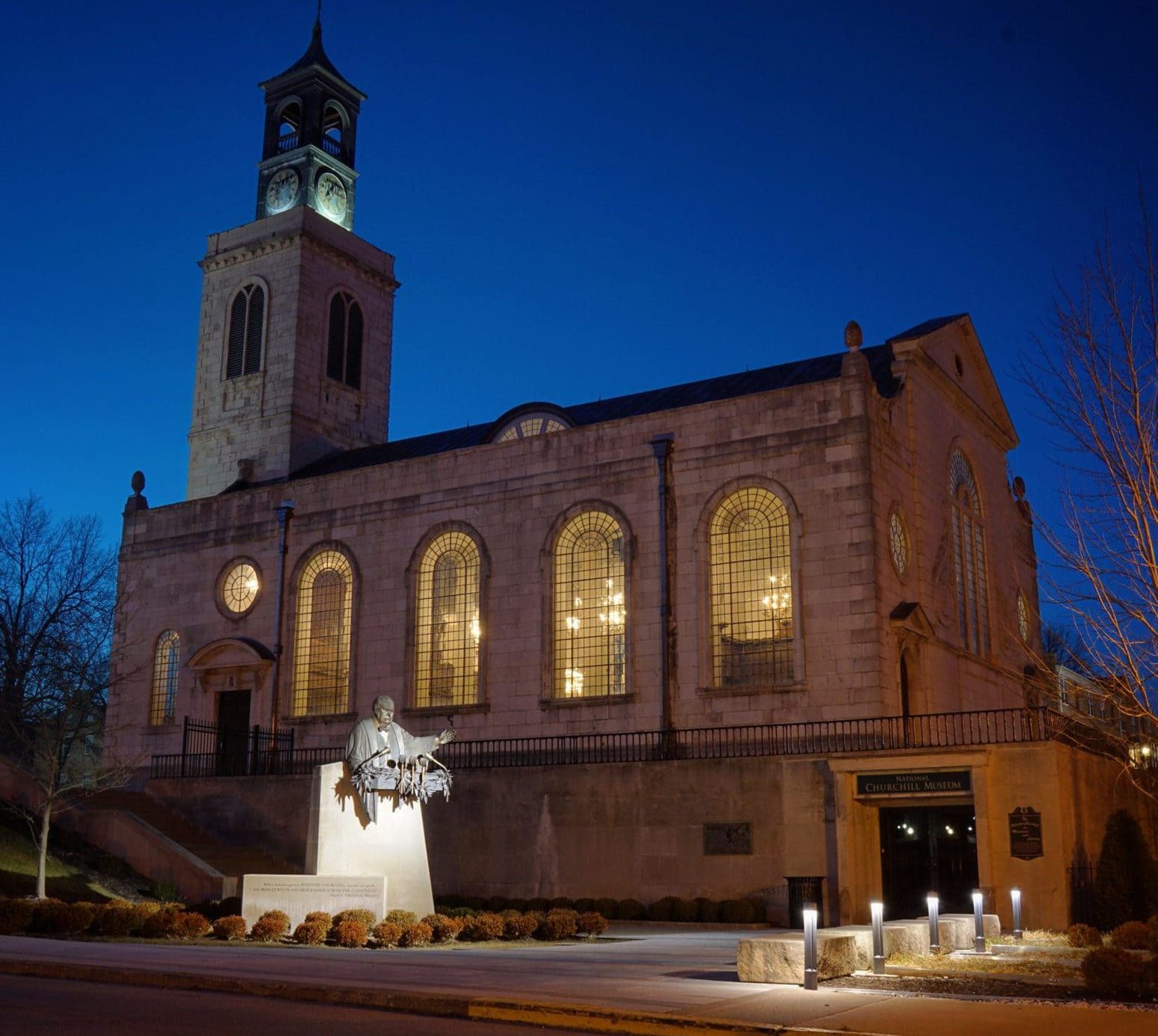
At the end of a long hallway leading through the museum is a stone set of winding stairs. These lead into the Church of St. Mary the Virgin, Aldermanbury, directly above the museum. The church, designed by Christopher Wren, famous 17th century architect, was moved to Fulton from London, stone by stone, and reassembled in 1967 at its present location to commemorate Churchill’s speech. It is the only Christopher Wren building in the United States. Even if there were no museum beneath it, the church would be reason enough to stop for a while in Fulton. Its interior was recreated and includes a pulpit, a baptismal font and a balcony crafted by English woodcarvers.
From the church, it’s just a few steps to the plaza, where a significant sculpture tops off the museum experience. Edwina Sandys, Churchill’s granddaughter, created the sculpture using eight sections of the Berlin Wall. Entitled “Breakthrough,” it is a dramatic reminder of the cold war and its effects on Berliners.
Plan on spending at least two hours when visiting the National Churchill Museum. Even after a whole afternoon’s tour you’ll leave wanting to come back again.
The Daum Museum of Contemporary Art
Campus of State Fair Community College, 3201 W. 16th St., Sedalia, open Tuesday – Fridays, 11a.m. to 5 p.m., Saturday–Sunday 1 p.m. to 5 p.m., closed Monday. No Charge.
The best thing about the Daum is that it can serve as a gateway to enjoying contemporary art for those who haven’t explored this form. For others who are familiar with the art or who might have some hanging on their walls, it can serve as a way to deepen their appreciation of well-known artists.
The Daum is a quiet, peaceful space, enclosing three levels of galleries. Sedalia may not be known as the center of the contemporary art world, but the Daum puts it on par with galleries in other major cities.
Having opened in 2002 with 300 pieces donated by Dr. Harold F. Daum, a retired radiologist, the museum now includes 1,500 pieces by some of the country’s most respected artists. Included in its collection are works by well-known artists such as Andy Warhol and Ansel Adams.
A visit to the museum starts outside on the front lawn. Several striking sculptures and large ceramic pieces draw the visitor’s attention to the building. One of the pieces evokes a group of dancers, swirling in a circle. On either side of the front door, two ceramic pieces set expectations for what’s inside. Both pieces are interesting to look at; they have shape and design, but it’s unclear what they represent, if anything. The important thing is that they catch your attention and begin shifting your focus, away from the buildings, cars and objects that make up our constructed reality and toward the strange and enticing world of contemporary art.
Don’t expect to see pastoral scenes or painted portraits that could be photographs. The walls of the Daum and its display areas are filled with more challenging images and shapes. You know it’s modern, but it feels familiar. Even the stair rails leading to the different floors are stylish, composed of a series of narrowly spaced horizontal rails. At the top of the stairwell hangs a sculpted glass piece by Chihuly, possibly the best-known glass artist in the nation.
Sculpture pieces range from torsos to ornamental plates and from abstract human shapes to bowls. In one painting, the main focus is on an anteater. Mixed-media pieces on the wall seem like studies in texture and color.
Although the art in this museum is different than more realistic paintings and sculptures, it has the same power to instill awe and a sense of beauty. Do you have to understand what the artist is trying to say if you are to appreciate this art? Not at all. All you need is an open mind and enough curiosity to experience the magic of contemporary art.

